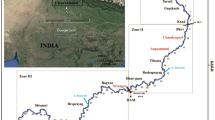Abstract
Almost at every mouth of the tributary creek of the Three Gorges in the Gezhouba Reservoir, the alluvial fans or alluvial cones formed the rapids, which are called rapids of creek mouth-bar. They are composed of pebble bed load with d>20 mm. Based upon geological and geomorphological investigations, the authors detect that the pebble bed load at the Gezhouba Reservoir comes from two sources, namely, the region mainly with limestone and The region mainly with pyrolith, and their converging area is within the Gezhouba Project. percentages of the pebble bed load are calculated. The calculated result stows that, 65% of pebble bed load comes from the region mainly with limestone, and 93% of the rapids of creek mouth-bar is distributed in the region mainly with limestone. Considering the water level fluctuations, the rapids of creek mouth-bar can be divided into 3 types i. e. flood water ones, medium water ones and low water ones. Due to the rise of water level after building the Gezhouba Reservoir, the navigable channels in the area of rapids of creek mouth-bar within varied back water region are improved, taking up 50% of all 12 rapids. But the rapids of creek mouth-bar in the tail region where the water level rises less than 1 m, the conditions of navigable channels are little improved and even deterioration, because of the continuous supply of pebble bed load. Therefore, those rapids must be regulated before the completion of the Three Gorges Project.
Similar content being viewed by others
References
Hydrologic Bureau, Yangtze Valley Planning Office. The deposition and the changes of navigable channel at reservoir region in the second stage operation of the Gezhouba Project. In: Proceedings of Sedimentation Engineering of the Three Gorges Project of the Yangtze. Beijing: Chinese Sciencce and Technology Press, 1989. 598–607 (in Chinese).
Lin Chengkun. Sediment and Environment in the Three Gorges and Gezhouba of the Yangtze-River. Nanjing: Nanjing University Press, 1989. 66–69. (in Chinese)
Lin Chengkun. Sedimentation and Fluvial Geomorphology. Nanjing: Nanjing University Press, 1992. 223–225. (in Chinese)
Lin Chengkun, Wei Te, Shi Liren. The source and quantity of gravel bed load of the Yangtze River at Gezhouba. In: Proceedings of the International Symposium on River Sedimentation. Beijing: Guanghua Press, 1980, 83–92 (in Chinese).
Lin Chengkun. Characteristics and quantity of pebble bed load at Gezhouba project of the upper reaches of the Yangtze. Journal of Chinese Geography, 1993, 3(3):33–47
Author information
Authors and Affiliations
Additional information
Supported by National Natural Sciences Foundation of China and Center of Material Analysis of Nanjing University.
Rights and permissions
About this article
Cite this article
Lin, C., Gao, X. Evolution of rapids of creek mouth-bar at Gezhouba Reservoir and the impacts on navigable channel in the upper reaches of the Changjiang River. Chin. Geograph.Sc. 6, 223–230 (1996). https://doi.org/10.1007/s11769-996-0024-3
Received:
Issue Date:
DOI: https://doi.org/10.1007/s11769-996-0024-3




